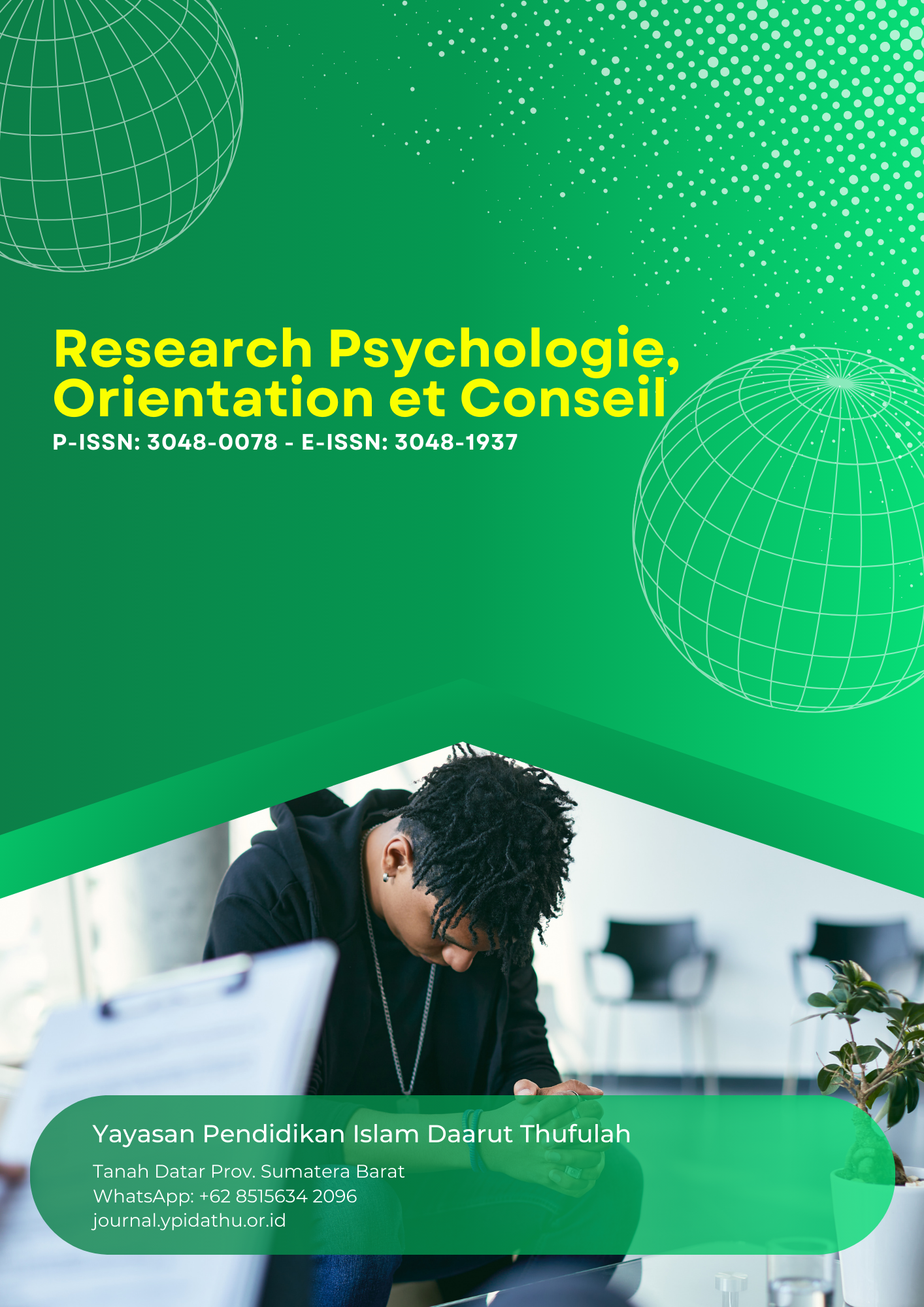Abstract
This research aims to determine the picture of happiness of new students. The research method used is the library research method which uses scientific articles as a source of research data. The analysis used is content analysis of the article. The results of this research show that t new students' happiness can be obtained from themselves and from their social environment. Happiness that originates from oneself, such as feelings of gratitude, health, a more optimistic outlook and a more positive attitude towards other people. Meanwhile, the source of happiness can also come from the social environment, such as the income earned, the quality of social relationships, social support and community. The impact of happiness on new students can have a positive impact including the ability to handle academic stress, as well as being more involved in campus activities.
Full text article
References
Adilah, M.A.R., & Widiasih, P.A. (2023). An overview of the meaning of happiness for migrant students abroad. Journal of Indonesian Psychological Science Volume 03, No 2 (2023), pp. 442—455, E-ISSN 2828-4577 https://10.18860/jips.v3i2.22850
Ahmad, N.A., Widianti, E., Somantri, I. (2021). Description of Happiness in Nursing Students. Journal of Mental Nursing (JKJ): Indonesian National Nurses Association Volume 9 No 1 Page 11 - 26, February 2021, e-ISSN 2655-8106, p-ISSN2338-2090 FIKKes Muhammadiyah University Semarang in collaboration with PPNI Central Java
Argyle, M. (2001). The Psychology of Happiness (2nd ed). New York: Routledge
Ariska, D., Zulida, N., Hanif, M., & Agus (2020). The Meaning of Happiness for Female Students in the Era of Millennials.ISSN:2548-4044 Psychoislamedia Journal of Psychology Volume 05 Number 01, 2020
Baumgardener, S. R., & Crothers, M. K. (2010). Positive psychology. New Jersey: Pearson Education, Inc.
Budiono (2022). Differences in Happiness Levels of Undergraduate Program Students and Professional Program Students, Faculty of Dentistry, Muhammadiyah University, Semarang Indonesian Journal of Dentistry Volume 2 Issue 1 Year 2022 Pages 16-19 URL https://jurnal.unimus.ac.id/index.php/IJD DOI http ://dx.doi.org/10.26714/ijd.v2i1.9868
Creswell, J. W. (2014). Research Design: Qualitative, Quantitative, and Mixed Methods Approaches (4th ed.). SAGE Publications.).
Creswell, J. W. (2014). Research Design: Qualitative, Quantitative, and Mixed Methods Approaches. London: SAGE Publications.
Diener, E. D. & Seligman, M. E. P. (2002). Very happy people. Psychological Science, 13(1), 81-84.
Diener.,& Seligman, M.E.P.(2002). Very Happy People. Psychological Science 13, no. 1 (2002): 81–84, https://doi.org/10.1111/1467-9280.00415. 5
Fowler, J., H., & Christakis, N.A. (2009). Dynamic Spread of Happiness in a Large Social Network: Longitudinal Analysis over 20 Years in the Framingham Heart Study. BMJ (Online) 338, no. 7685 (2009): 23–26, https://doi.org/10.1136/bmj.a2338.
George, M. W. (2008). The Elements of Library Research: What Every Student Needs to Know. Princeton University Press.
Gilman, R. (2001). The relationship between life satisfaction, social interest, and frequency of extracurricular activities among adolescent students. Journal of Youth and Adolescence, 30(6), 749-767.
Hasibuan, A.D. (2020). Factors that Influence Student Learning Happiness during the Covid-19 Pandemic. Journal of Education and Counseling http://jurnal.uinsu.ac.id/index.php/al-irsyad ISSN 2686-2859 (online) ISSN 2088-8341 (print) Vol. 10, no. 1, January-June 2020
Helliwell, J.F., & Putnam, R.D. (2004). The Social Context of Well-Being. Philosophical Transactions of the Royal Society B: Biological Sciences 359, no. 1449 (2004): 1435–46, https://doi.org/10.1098/rstb.2004.1522.
Huta, V., & Waterman, A.S. (2014). Eudaimonia and Its Distinction from Hedonia: Developing a Classification and Terminology for Understanding Conceptual and Operational Definitions. Journal of Happiness Studies 15, no. 6 (2014): 1425–56, https://doi.org/10.1007/s10902-013-9485-0.
Liem, G. A. D., & Martin, A. J. (2012). Peer relationships and adolescents' academic and non-academic outcomes: Same-sex and opposite-sex peer effects. Journal of Adolescence, 35(1), 142-152.
Lyubomirsky, King, and Diener, “The Benefits of Frequent Positive Affect: Does Happiness Lead to Success?
Lyubomirsky, S., King, L., & Diener. (2005). The Benefits of Frequent Positive Affect: Does Happiness Lead to Success? Psychological Bulletin 131, no. 6 (2005): 803–55, https://doi.org/10.1037/ 0033-2909.131.6.803.
Mehrdadi, A., Sadeghian, S., DirekvandMoghadam, A., & Hashemian, A. (2016). Factors influencing happiness: A cross-sectional study in the Iranian youth. Journal of Clinical and Diagnostic Research, 10(5), VC01– VC03. https://doi.org/10.7860/JCDR/2016/1 7970.7729
Pascoe, M. C., Hetrick, S. E., & Parker, A. G. (2020). The impact of stress on students in secondary school and higher education. International Journal of Adolescence and Youth, 25(1), 104-112.
Pavot, W., & Diener, E. (2008). The Satisfaction With Life Scale and the Emerging Construct of Life Satisfaction. The Journal of Positive Psychology, 3(2), 137-152.
Prafitralia, A. (2023). Analysis of Happiness Factors in Generation Z Students. Psychospiritual: Journal of Trends in Islamic Psychological Research Vol. 2, no. 1 (2023), 1-14 e-ISSN: 2986-7657 ? DOI: 10.35719/psychospiritual.vxix.xx
Putra, A.H., & Hariko, R. (2023). Descriptive Study of Happiness in New Students. Indonesian Counseling Journal http://ejournal.unikama.ac.id/index.php/JKI ISSN: Print 2475-888X–Online 2476-8901Vol. 8 No. 2, April 2023. p. 57–62
Ryan, R. M., & Deci, E. L. (2000). Self-determination theory and the facilitation of intrinsic motivation, social development, and well-being. American Psychologist, 55(1), 68-78.
Seligman, M. E. P. (2011). Flourish: A Visionary New Understanding of Happiness and Well-being. New York: Free Press.
Steptoe, A., Dockray, S., & Wardle, J. (2009). Positive Affect and Psychobiological Processes Relevant to Health. J Press, 77(46), 1747– 1776. https://doi.org/10.1111/j.1467- 6494.2009.00599.x.
Steptoe, A., & Wardle, J. (2011). Positive Affect Measured Using Ecological Momentary Assessment and Survival in Older Men and Women. Proceedings of the National Academy of Sciences of the United States of America 108, no. 45 (2011): 18244–48, https://doi.org/10.1073/pnas.1110892108.
Sugiyono. (2014) The Concept of Multicultural Education: National Journal (2016). Quantitative Combination of Qualitative Methods Research Methods).Bandung: Alfabeta.
Sugiyono. (2017). Quantitative, Qualitative and R&D Research Methods. Bandung: Alphabeta.
Vaillant, G. E. (2000). Adaptive mental mechanisms: Their role in positive psychology. American Psychologist, 55, 89–98. https://doi.org/10.1037/0003-066X
Zed, M. (2014). Library Research Methods. Indonesian Obor Foundation
Authors
Copyright (c) 2024 Novita Maulidya Jalal

This work is licensed under a Creative Commons Attribution-ShareAlike 4.0 International License.





